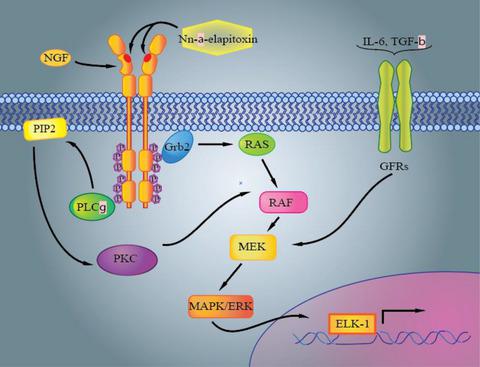当前位置:
X-MOL 学术
›
J. Neurochem.
›
论文详情
Our official English website, www.x-mol.net, welcomes your
feedback! (Note: you will need to create a separate account there.)
A unique snake venom neuritogenesis mechanism: A cornerstone in the treatment of neurodegenerative diseases?
Journal of Neurochemistry ( IF 4.2 ) Pub Date : 2020-10-19 , DOI: 10.1111/jnc.15196 Luisa C. Hernández‐Kelly 1 , Arturo Ortega 1
Journal of Neurochemistry ( IF 4.2 ) Pub Date : 2020-10-19 , DOI: 10.1111/jnc.15196 Luisa C. Hernández‐Kelly 1 , Arturo Ortega 1
Affiliation

|
Neurodegenerative diseases are a worldwide health problem and are a major cause of death and disability. A progressive loss of defined neuronal populations is triggered by a diverse array of stimuli that converge in deficient neurotrophic signaling. Therefore, much effort has been placed in recent years in the characterization of the molecular mechanisms associated with the structure and function of neurotrophins, its receptors, signaling strategies, and their target genes. This Editorial highlights an impressive study by the group of Prof. Ashis K. Mukherjee, a renowned specialist in snake venoms, in which a component of the Indian Cobra N.naja venom with no significant similarity to nerve growth factor, is shown to induce sustained neuritogenesis. An elegant transcriptomic and functional analysis of this component, named Nn‐α‐elapitoxin, mapped novel domains in mammalian neurotrophic receptors that trigger both conventional and novel signal cascades that support neurite extension in the PC‐12 neuronal model system. The authors discuss their findings in the context of the paradoxical neurite outgrowth properties of this toxin which originate in their unique receptor binding site. This study takes an important step towards a better understanding of the complexity of neuronal development and maintenance of the nervous system and provides a potential target to improve neurotrophic signaling, independent of endogenous growth factors, in the diseased brain.
中文翻译:

独特的蛇毒神经形成机制:治疗神经退行性疾病的基石?
神经退行性疾病是世界范围内的健康问题,并且是死亡和残疾的主要原因。限定的神经元种群的逐渐丧失是由收敛于缺陷性神经营养信号的多种刺激触发的。因此,近年来,在与神经营养蛋白的结构和功能,其受体,信号传导策略及其靶基因相关的分子机制的表征方面已付出了很多努力。这篇社论重点介绍了蛇毒的著名专家Ashis K. Mukherjee教授的一项令人印象深刻的研究,该研究是印度眼镜蛇N.naja的组成部分与神经生长因子无明显相似性的毒液可诱导持续的神经形成。对该组件进行的转录组学和功能分析(称为Nn-α-apitoxin),在哺乳动物神经营养受体中定位了新结构域,该结构域触发了支持PC-12神经元模型系统中神经突扩展的常规和新型信号级联。作者在这种毒素的自相矛盾的神经突向外生长特性的背景下讨论了他们的发现,这种特性起源于它们独特的受体结合位点。这项研究朝着更好地理解神经元发育和神经系统维持的复杂性迈出了重要的一步,并为改善患病大脑中独立于内源性生长因子的神经营养信号提供了潜在的目标。
更新日期:2020-12-10
中文翻译:

独特的蛇毒神经形成机制:治疗神经退行性疾病的基石?
神经退行性疾病是世界范围内的健康问题,并且是死亡和残疾的主要原因。限定的神经元种群的逐渐丧失是由收敛于缺陷性神经营养信号的多种刺激触发的。因此,近年来,在与神经营养蛋白的结构和功能,其受体,信号传导策略及其靶基因相关的分子机制的表征方面已付出了很多努力。这篇社论重点介绍了蛇毒的著名专家Ashis K. Mukherjee教授的一项令人印象深刻的研究,该研究是印度眼镜蛇N.naja的组成部分与神经生长因子无明显相似性的毒液可诱导持续的神经形成。对该组件进行的转录组学和功能分析(称为Nn-α-apitoxin),在哺乳动物神经营养受体中定位了新结构域,该结构域触发了支持PC-12神经元模型系统中神经突扩展的常规和新型信号级联。作者在这种毒素的自相矛盾的神经突向外生长特性的背景下讨论了他们的发现,这种特性起源于它们独特的受体结合位点。这项研究朝着更好地理解神经元发育和神经系统维持的复杂性迈出了重要的一步,并为改善患病大脑中独立于内源性生长因子的神经营养信号提供了潜在的目标。











































 京公网安备 11010802027423号
京公网安备 11010802027423号